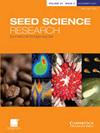Seed dormancy concepts in orchids: Dendrobium cruentum as a model species
IF 2.1
3区 生物学
Q2 PLANT SCIENCES
引用次数: 0
Abstract
Abstract Generally, orchids produce dust-like seeds in which endosperm reduction and embryo undifferentiation represent a derived state shared with species in about 11 other plant families. Orchid seeds are proposed to have a special kind of morphological or morphophysiological dormancy. We test this proposition, overcoming several design limitations of earlier studies, specifically that the in vitro germination method for orchid seeds uses pro-oxidants for disinfection and incorporates nitrate in the medium; both ‘treatments’ might contribute to dormancy breaking, potentially confounding judgement on the depth and nature of the dormant state. Seeds of the tropical orchid Dendrobium cruentum Rchb. f., were sown both in vitro, on a nutrient medium, and ex vitro, on plain agar omitting prior disinfection with sodium hypochlorite. Seeds previously stored and fresh seeds were incubated under combinations of vitro conditions, light treatments, constant or alternating temperatures and nitrate concentration. Seeds of D. cruentum are very small but have a large embryo that occupies most of the seed. Over a range of constant temperature seeds germinated to the spherical protocorm stage just as well ex vitro as in vitro. Neither light nor nitrate were prerequisites for ex vitro germination. The ability of D. cruentum seed to germinate in the absence of environmental or chemical stimuli suggests that mature seed can be non-dormant. Our results support the proposition that neither all DUST seed fit a dormancy class nor all orchids produce morphological or morphophysiological seeds. Finally, embryo/seed volume determinations in orchids may prove as valuable in studies on the evolution and ecology of germination and dormancy as embryo:seed ratios in other angiosperm species.兰科植物种子休眠的概念:作为模式种的金石斛
摘要一般来说,兰花会产生类似灰尘的种子,其中胚乳减少和胚胎未分化代表了与其他11个植物科的物种共享的衍生状态。兰花种子被认为具有一种特殊的形态或形态生理休眠。我们测试了这一命题,克服了早期研究的几个设计限制,特别是兰花种子的体外发芽方法使用促氧化剂进行消毒,并在培养基中加入硝酸盐;这两种“治疗”都可能有助于打破休眠,可能会混淆对休眠状态深度和性质的判断。热带兰花石斛的种子。f.,在营养培养基上进行体外播种,并在普通琼脂上进行离体播种,省略了事先用次氯酸钠消毒。预先储存的种子和新鲜种子在体外条件、光照处理、恒定或交替温度和硝酸盐浓度的组合下孵育。克鲁恩图姆的种子很小,但有一个很大的胚胎,占据了大部分种子。在一定范围的恒温条件下,种子发芽到球形原球茎阶段,体外和体外一样好。光和硝酸盐都不是体外发芽的先决条件。D.cruentum种子在没有环境或化学刺激的情况下发芽的能力表明,成熟的种子可以是非休眠的。我们的结果支持这样一个命题,即无论是所有的DUST种子都不属于休眠类,也不是所有的兰花都能产生形态或形态生理种子。最后,兰花胚胎/种子体积的测定在研究发芽和休眠的进化和生态学方面可能与其他被子植物物种的胚胎与种子比例一样有价值。
本文章由计算机程序翻译,如有差异,请以英文原文为准。
求助全文
约1分钟内获得全文
求助全文
来源期刊

Seed Science Research
生物-植物科学
CiteScore
3.60
自引率
4.80%
发文量
23
审稿时长
>12 weeks
期刊介绍:
Seed Science Research, the official journal of the International Society for Seed Science, is a leading international journal featuring high-quality original papers and review articles on the fundamental aspects of seed science, reviewed by internationally distinguished editors. The emphasis is on the physiology, biochemistry, molecular biology and ecology of seeds.
 求助内容:
求助内容: 应助结果提醒方式:
应助结果提醒方式:


